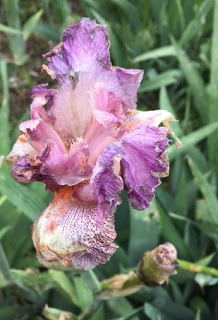 |
| 'Wonder Blue' |
 I thoroughly enjoyed her brief show this season, a spectator to her splendor, yet she is a pretender, a false idol for lilac worshipers. To my knowledge, there is no true blue pigment in Syringa vulgaris, just as there is no blue pigment in roses, but against the deep purple backdrop of 'Yankee Doodle', this lavender lass suffices for blue in my border. Shorter than many of her cousins, however, she also is weaker, the least vigorous of all the lilacs I grow. Compactness, in lilacs, may not be a virture. Year-to-year, I'm happy to keep a few leggy canes growing to gift me these soul-mending tresses, but its survival always seems a little tenuous, as if beauty's cost were frailty.
I thoroughly enjoyed her brief show this season, a spectator to her splendor, yet she is a pretender, a false idol for lilac worshipers. To my knowledge, there is no true blue pigment in Syringa vulgaris, just as there is no blue pigment in roses, but against the deep purple backdrop of 'Yankee Doodle', this lavender lass suffices for blue in my border. Shorter than many of her cousins, however, she also is weaker, the least vigorous of all the lilacs I grow. Compactness, in lilacs, may not be a virture. Year-to-year, I'm happy to keep a few leggy canes growing to gift me these soul-mending tresses, but its survival always seems a little tenuous, as if beauty's cost were frailty.
Why is it that, in our quest for the quixotic, our pursuit of the perfect, we accept less for a close piece of the prize? Is a beauty mark really the shining crown of a supermodel, the completion of a beauty such as Cindy Crawford, or is it merely a mole that we tolerate to bask in otherwise near-glory while knowing that melanoma lurks around the Darwinian corner? Did Father John Fiala, its hybridizer, perpetuate 'Wonder Blue', fully aware of all its flaws but loving it still, merely for a pigment combination? Is Man now the sole judge of evolution, the unnatural selector of the weakened unique? Are we mere flawed assessors of beauty who lack a broader view of its true meaning?
 |
| 'Sensation' |
Cast out these false idols, I beseech thee. Do not follow the weak-minded, superficially-oriented ProfessorRoush into the gardening wilderness, content to oversee the mere survival of the odd and unique. Seek out true beauty, the beauty of strength and resiliency against all. You'll be a happier gardener for it, albeit deprived of the bluest of lilacs.














































